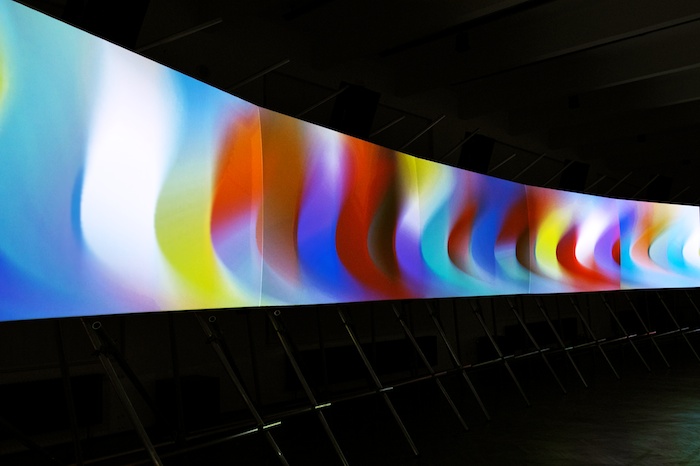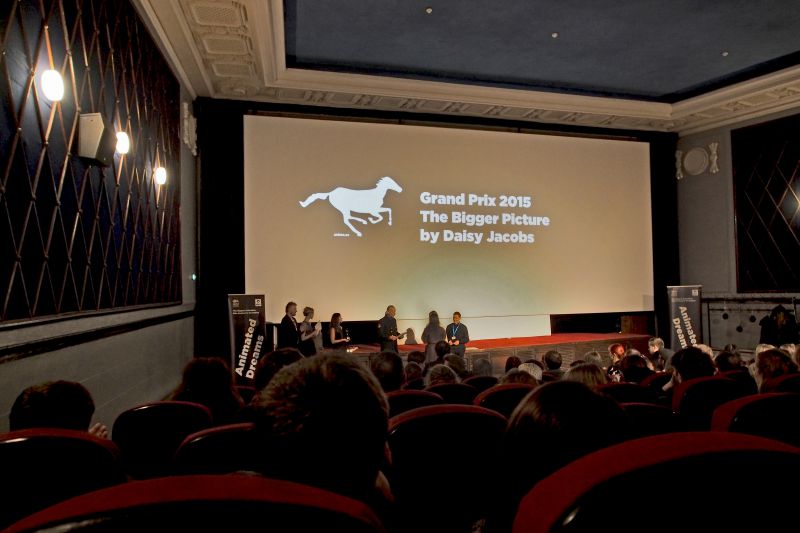|
|
||
|
Pro Tools
FILMFESTIVALS | 24/7 world wide coverageWelcome ! Enjoy the best of both worlds: Film & Festival News, exploring the best of the film festivals community. Launched in 1995, relentlessly connecting films to festivals, documenting and promoting festivals worldwide. Working on an upgrade soon. For collaboration, editorial contributions, or publicity, please send us an email here. User login |
Moon Blink in competition at Animated Dreams Film Festival 2015Rainer Kohlberger is a Berlin-based visual artist from Austria. His latest 10 minutes short film "Moon Blink" is a visual journey into the individual minds of the audience. After having been selected for the Tiger Award competition for Short Films at IFFR 2015 in Rotterdam, it was in competition at Animated Dreams Film Festival in Tallinn this november. Rainer introduces himself and explains us the idea behind his work.
Visual installation of the movie ''Moon Blink'' Question : Where did you start to learn about visual arts and music ? I'm a kind of self-taught. I studied film and sound in a traditional way, and I learned computer programming when I was younger, later I saw that it’s possible to combine these skills with moving images. So, I started to code all my visual works with a visual programming language. The original model of synthesis was to create sound with patching cables. This concept has been abstracted to software about 30 years ago and I use this system so my work can also be explained as synthesis more than animation. I had this idea to mix programming and visual arts when I completed my studies. When I was younger I earned money by making websites, that’s where I created my first programmatically generated visuals. That's where I started to find out that it is possible to be creative in a way by using code and procedural thinking to generate abstract art works. I started to learn mostly through experimenting — "fake it till you make it", an attitude, that I absorbed when I was younger and still holds true today. Technically the practice is closely related to games animation, as games also run in realtime. When I connect two cables virtually, I see the result immediately. It's like painting. There is no rendering time, and this technology would have never existed without the gaming industry. They put a lot of money into graphic cards for example, and various softwares were created for the arts. That is already a derivation from the original purpose, and now I'm using these softwares to experiment and see what's happening when you use them against the grain. During my studies I combined the thinking behind abstraction, art and algorithms. There are a lot of aspects you can find and similarities into the process of creating artworks and procedural systems. There is a lot of algorithms involved in creating artworks. It's not something you necessarily have to do with computers, but thinking in terms of algorithms and procedures, that is an interesting topic. Question : Can you speak about the process of your work ? I use a lot of aleatoric processes that are superimposed with each other. It's a feedback process where you immediately test your output and evaluate it. Then I decide what's in, where I go next and what I will delete or not bother any further. There is a lot of errors that are happening but if I like those I can instantly use them. It's an artistic decision if something is valid or not. It's not like a magic box where you put something in and the visual result comes out. I have a bigger idea about where to go, or about the current thinking about creating a film, an installation artwork or a live performance. Then I start working on it, and of course I don't precisely end up where I want. It's more like a virtual goal because there's a lot of errors and random processes so I end up somewhere else. Question : Where does your inspiration comes from ? James Turell is a big inspiration to me. There is a lot of interesting concepts behind his work. He is working with light, and sometimes I refer to my films also as light, in HD resolution. I am also fascinated how the "Ganzfeld" can mess with our brains. For me the perfect cinema is one where there is nothing outside of your vision, so you could be drown completely into the image. And where the security exit lights are gone. But I also get inspired by the 1960s american avant-garde artists like Tony Conrad and Phill Niblock. There is a lot of interest again nowadays in the long form, some of their works can last 5 or 7 hours, it's a completely different experience. So my films are also live installations and when I show them as installations they run in a loop, so the idea is to make them going on forever. Infinity is a fascinating topic. Phill Niblock and Tony Conrad are both musicians and over 80 years old, but they are still working, touring, and travelling all over the world, so that's also an inspiration to me. At their age they still find new frontiers to break in. My inspiration also comes from combining different media like sounds and visuals, as Tony Conrad for example, who is a filmmaker and a musician. I create the sounds by myself for my films. Question : Are you trying to reach a specific point by mixing video with music ? I don't just combine video and music to translate one channel into another channel, or one sense into another sense. What I try to do is to create a third sense or a vision. Something that wouldn't be there if one of the two is missing. Something that is in between the ear and the eye. You start to see differently because of what you're hearing. You can see something differently because you hear a certain frequency. It can be the same frequency for two different images but you will see them differently. When you start to make connections your brain tries to do combinations all the time. The combination between sound and vision is not too hard so you can match pretty much everything, your brain will make connections and it will be taking something out of it. My idea is to bend this concept of combination. It's about the individual experiences of everyone in a cinema. By challenging the visual system with strong images, every brain does something different. For some it's not even possible to watch my works because they are too far away from my kind of thinking. I listen to a lot of noise music for example and some of that music won't even be accepted by some people as music. That is where the connection is strong to the way of thinking. If you don't accept to think, you can't deal with unfamiliar things out there. My work is about to leave space for the audience to think. But at the same time, there exists a very physical connection with their bodies.
Alain Andrieux
10.12.2015 | Alain Andrieux's blog Cat. : ANIMATED DREAMS Asifa Austria Black Nights Black Nights Film Festival James Turell Phill Niblock Rainer Kohlberger Talllinn Black Nights Film Festival Tiger Award Tony Conrad
|
LinksThe Bulletin Board > The Bulletin Board Blog Following News Interview with IFTA Chairman (AFM)
Interview with Cannes Marche du Film Director
Filmfestivals.com dailies live coverage from > Live from India
Useful links for the indies: > Big files transfer
+ SUBSCRIBE to the weekly Newsletter Deals+ Special offers and discounts from filmfestivals.com Selected fun offers
> Bonus Casino
User imagesAbout Alain AndrieuxThe EditorUser contributions |



























